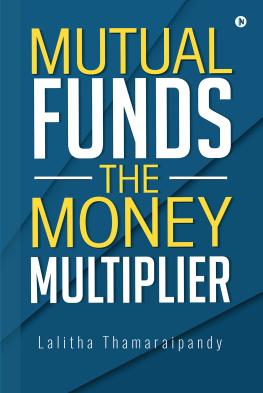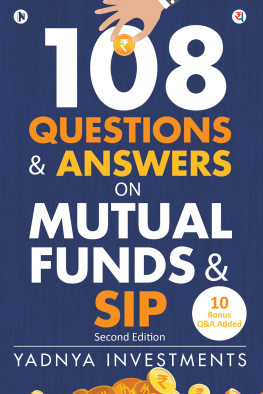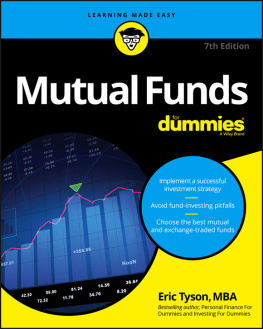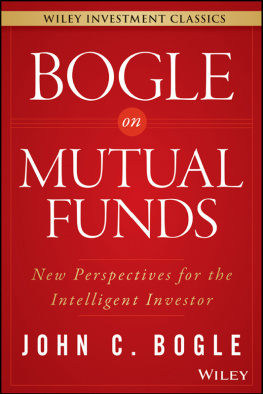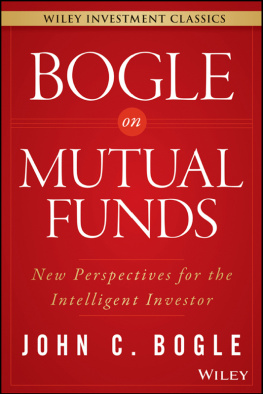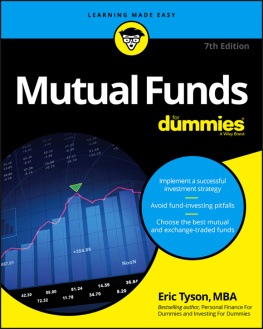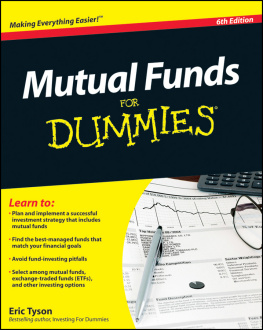
SECTION I
INTRODUCTION
A s Benjamin Franklin succinctly put it, An investment in knowledge always pays the best interest.
Mutual fund a globally proven investment vehicle is slowly but steadily finding a place in the investment itinerary of Indians. There is no magic formula for successful mutual fund investing all it requires is common sense, emotional discipline and a clear understanding of the concept.
John C. Bogle, in his preface to Common Sense on Mutual Funds: New Imperatives for the Intelligent Investor rightly pointed out, intelligent investing turns out to be little more than common sense and sound reason. The sooner investors realise that elemental principle, the better will be their ability to accumulate the maximum possible amount of capital for their financial security.
To invest successfully over a lifetime does not require a stratospheric IQ, unusual business insights, or inside information. Whats needed is a sound intellectual framework for making decisions and the ability to keep emotions from corroding that framework, so said Warren Buffet in his preface to the fourth edition of Benjamin Grahams The Intelligent Investor .
In this book, Mutual Funds: The Money Multiplier , the concept of mutual funds has been introduced against the backdrop of investment planning. Such a holistic view will enable readers to place mutual fund investing in a proper perspective. Due care has been taken to ensure that readers understand the concept and enrich their knowledge and wealth. Minute details are dealt with precision and clarity to drive home the concept and prepare the readers to fearlessly enter the world of mutual funds.
Welcome to the world of Mutual Funds
Preface
The high decibel advertisements for mutual funds cannot but be drowned in the ensuing din. Such is the voracity with which they are marketed. Books on this much-touted topic by stalwarts in the financial circles are available a dime a dozen. Therefore, the rationale for another book on this topic does not hold water.
What then could be the motivation for yet another book on Mutual Funds ? There is a dearth of books on this topic by Indian authors. It is my intention to encapsulate all that is there for you to know about Indian mutual funds in a lucid and concise style with a mark of authenticity, of course. In this book, it will be my endeavour to demystify the concept of mutual funds so that even a layman can reap the benefits it offers and build his wealth. This book is not intended for professional investors but for ordinary investors, who need guidance while investing .
The genesis of this book dates back to nearly a decade ago when I started writing a blog on the site www.indianmutualfund.blogspot.com titled The Money Multiplying Matrix of Mutual Funds. The rousing reception the site had with the investing public, notably the novices in this field, prompted me to go ahead with this book on mutual funds.
The sole source of inspiration for this book was none other than my life partner, P. Palavesa Muthu, whose single-minded devotion and constant encouragement was instrumental in the transformation of my blog into a book. The entire credit for editing and fine tuning this book and giving it the present shape goes to my father, who instilled in me the love for the written word as a child. The willing co-operation of my family members my mother, brother, sister, son and daughter deserves special mention.
Last but not least, I am indebted to the entire team of Notion Press for the excellent job done by them.
Lalitha
Kuwait,
February 2017
Dedicated to
THE ALMIGHTY
without whose grace this book would not have
seen the light of the day

Notion Press
Old No. 38, New No. 6
McNichols Road, Chetpet
Chennai - 600 031
First Published by Notion Press 2017
Copyright Lalitha Thamaraipandy 2017
All Rights Reserved.
ISBN 978-1-946641-20-5
This book has been published with all reasonable efforts taken to make the material error-free after the consent of the author. No part of this book shall be used, reproduced in any manner whatsoever without written permission from the author, except in the case of brief quotations embodied in critical articles and reviews.
The Author of this book is solely responsible and liable for its content including but not limited to the views, representations, descriptions, statements, information, opinions and references [Content]. The Content of this book shall not constitute or be construed or deemed to reflect the opinion or expression of the Publisher or Editor. Neither the Publisher nor Editor endorse or approve the Content of this book or guarantee the reliability, accuracy or completeness of the Content published herein and do not make any representations or warranties of any kind, express or implied, including but not limited to the implied warranties of merchantability, fitness for a particular purpose. The Publisher and Editor shall not be liable whatsoever for any errors, omissions, whether such errors or omissions result from negligence, accident, or any other cause or claims for loss or damages of any kind, including without limitation, indirect or consequential loss or damage arising out of use, inability to use, or about the reliability, accuracy or sufficiency of the information contained in this book.
Chapter 1
What is a Mutual Fund?
Back to Basics
Mutual Funds Defined and Explained
SEBI (Mutual Fund) Regulations, 1993, define a mutual fund as a fund established in the form of a trust by a sponsor to raise money by the trustees through the sale of units to the public under one or more schemes for investing in securities in accordance with these regulations.
At the outset, it would be best to limit ourselves to explaining mutual funds in laymans terms. A graphic description of the constituents and legal composition of mutual funds in the subsequent section will serve as a self-explanatory follow-up to the formal, legalistic definition above.
In common parlance, a mutual fund is an investment vehicle that enables a number of investors with common financial goals to pool their money and have it jointly managed by a professional investment manager. A mutual fund pools the money of many investors and invests it in shares or debentures, bonds, etc. The fund manager invests the money in a portfolio of marketable securities in accordance with specific investment criteria, which are spelled out in the prospectus, the official booklet that describes the mutual fund. Investors, therefore, know what they are getting into and can match their investment objective to that of a fund.
The pooled money has greater buying power than one investor alone can command. A fund can own hundreds of different securities. Thus, its success is not dependent on how just one or two companies perform, but on the performance of all the stocks or securities which the fund is holding. The ownership remains in the hands of the investors who have pooled in the funds. A mutual fund is, thus, a financial intermediary that is managed by investment professionals and other service providers, who earn a fee from the fund for their services. Mutual fund is the purest form of financial intermediary because there is almost perfect pass through of money between investors and the securities in which the fund invests. Investors are indicated a priori in what type of securities their funds will be invested. The investors share in the fund is denominated by units whose value is updated on a daily basis.

